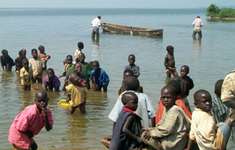Population biology
Due to its importance as an intermediate host for Schistosoma mansoni, the parasite that causes intestinal schistosomiasis in humans, scientists have long studied Biomphalaria snails, to try to understand more about the dynamics of the disease.
However, despite East Africa being one of the regions most heavily afflicted by intestinal schistosomiasis, the population dynamics of B. choanomphala in Lake Victoria as a whole have never been looked at in detail. Current research at the Natural History Museum is trying to do just that.

A typical transmission site of intestinal schistosomiasis on Lake Victoria
Museum research
A genetic database is being compiled, looking at individuals from 30 distinct sites around Lake Victoria, from:
- Uganda
- Tanzania
- Kenya
By looking at 3 separate genetic regions (2 mitochondrial and 1 nuclear, in the form of numerous microsatellite loci), the study expects to learn more about:
- the levels of genetic structuring within these snails
- whether there are any geographical patterns to their genetic diversity
- whether population expansion has taken place
Did humans influence a rapid population expansion of B. choanomphala?
In the 1940s, Lake Victoria was home to a remarkable and unique diversity of cichlids, a type of fish. Although the lake was very young, having last dried out as recently as 15,000 years ago, it contained over 300 species of cichlid. According to molecular evidence, the majority of these had arisen since the last dry period.
As well as being a remarkable example of speciation, the vast diversity of the cichlids was ecologically important, as species were forced to adapt to increasingly specialised niches in order to survive the intense competition from other fish. One whole group adapted to molluscivory - the obligate eating of snails and other freshwater molluscs.
In Lake Malawi, until recently, cichlid fishes have been observed to be very important in keeping numbers of Biomphalaria and other biomedically important snails down, reducing the transmission of their parasitic diseases as a result.
In Lake Victoria, an environmental tragedy occurred in the 1950s. A different kind of fish, the Nile perch, was introduced into the lake to stimulate fisheries and tourism. A voracious predator, it rapidly wiped out virtually all of the 300+ species of native cichlid.
Comparative studies with Lake Malawi, where overfishing of cichlids is currently underway, have suggested that the introduction of the Nile Perch could have led to rapid population expansion of the B. choanomphala populations in Lake Victoria, exponentially increasing the risk of schistosomiasis transmission in the region as a result. Through population genetic analyses of these snails, researchers at the Museum hope to test whether this hypothesis is correct.